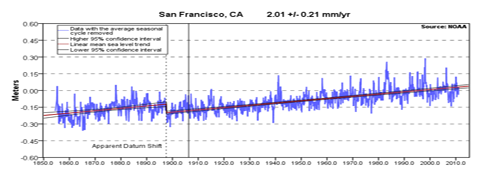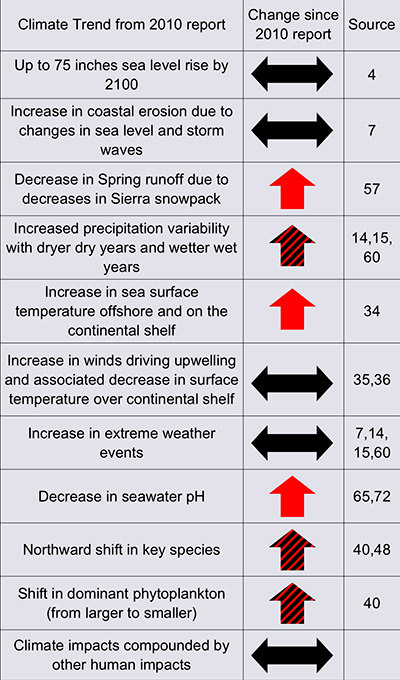
2010 Climate Impacts Report
In 2010, a joint working group of the Greater Farallones and Cordell Bank Sanctuary Advisory Councils synthesized the best available knowledge on observed and projected physical and biological impacts from climate change in north-central California coast and ocean ecosystems, authoring the report "Climate Change Impacts: Gulf of the Farallones and Cordell Bank National Marine Sanctuaries". This report was the first to systematically assess the impacts of climate change on Sanctuary resources, and was the outcome of a year and a half of intensive collaboration among local experts representing 16 agencies, organizations, and academic institutions to assess and downscale global climate change information into a regional climate change survey. An extensive suite of potential climate change impacts to habitats, plants, and animals within the San Francisco Bay Area's unique ocean and coastal zones were detailed, with 11 major climate impacts and trends identified:
- Observed increase in sea level
- Expected increase in coastal erosion associated with changes in sea level and storm waves
- Observed decrease in spring runoff of freshwater through San Francisco Bay
- Observed increase in precipitation variability (drier dry years, wetter wet years)
- Observed increase in surface ocean temperature offshore of the continental shelf
- Observed increase in winds driving coastal upwelling of nutrient-rich waters and associated observed decrease in surface ocean temperature over the continental shelf
- Observed increase in extreme weather events (winds, waves, storms)
- Expected decrease in seawater pH, due to uptake of carbon dioxide by the ocean
- Observed northward shift of key species
- Possible shift in dominant phytoplankton (from diatom to dinoflagellate blooms)
- The potential for effects of climate change to be compounded by parallel environmental changes associated with local human activities
Download Climate Change Impacts Report (2.8MB PDF)
2020 Climate Change Impacts Profile

The table summarizes each of the major climate trends from the original report and identifies if the trend remains the sameor has been adjusted upward. Other changes projected in the report have already been, or are being, observed and are expected to increase. None were adjusted downward. Detailed information on trends can be found throughout the 2020 Climate Impacts Report.
In the decade since the 2010 Climate Impacts Report was published, our understanding of climate change has advanced and predictions have been refined. In this recently-published Climate Change Impacts Profile, developed by the ONMS Climate Coordinator in consultation with GFNMS staff, key impacts identified in the 2010 report were re-assessed, with updated information and citations. While some trends identified in the 2010 report remain the same, many are accelerating faster than initially expected. The below table summarizes each of the major climate trends from the original report and identifies if the trend remains the same or has been adjusted upward. Other changes projected in the report have already been, or are being, observed and are expected to increase. None of the impacts were adjusted downward. Detailed information on trends can be found throughout this report.
Download Climate Change Impacts Profile (9.7MB PDF)

